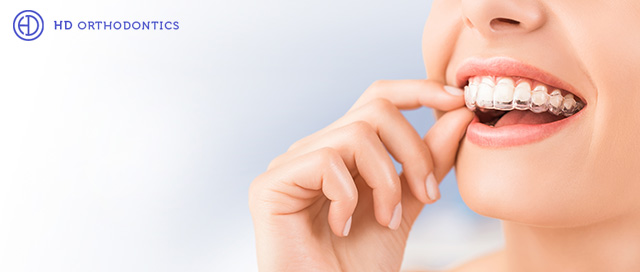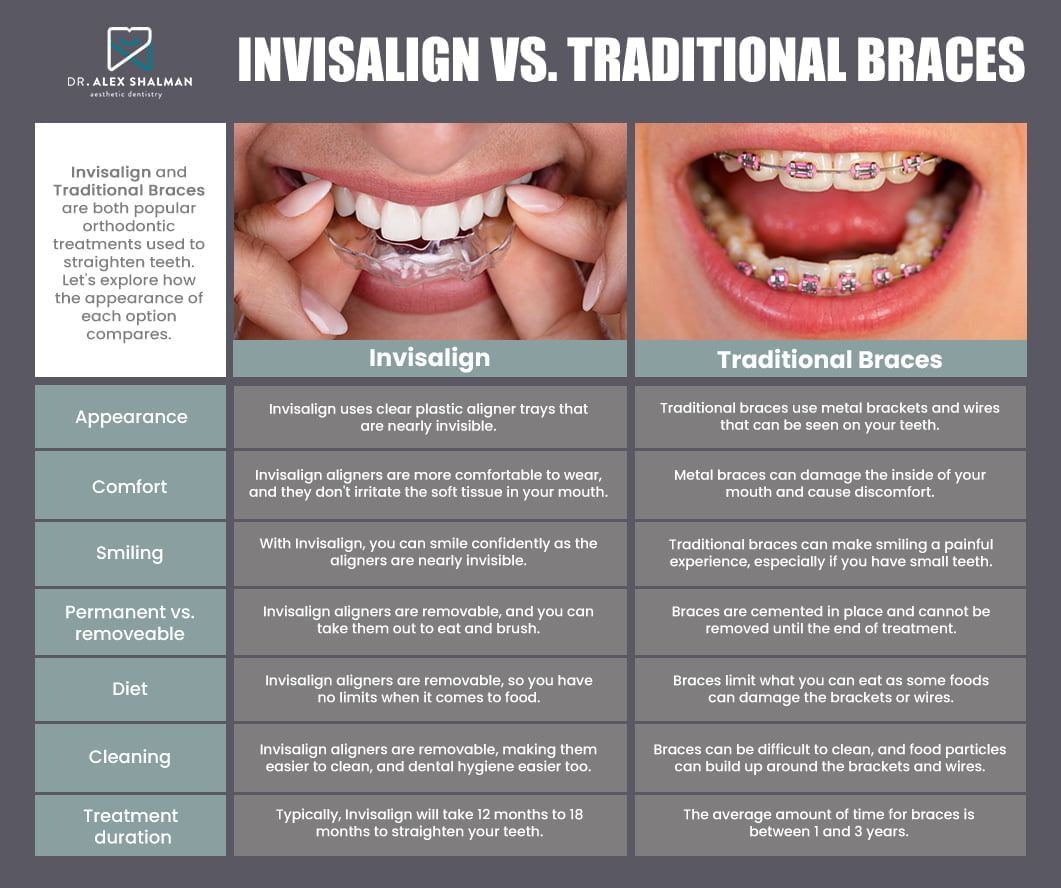Maintaining Oral Health While Making Use Of Invisalign: Tips for a Smooth Experience
Maintaining Oral Health While Making Use Of Invisalign: Tips for a Smooth Experience
Blog Article
Invisalign vs. Conventional Dental braces: Which Option Is Right for You?
When thinking about orthodontic treatment, the choice between Invisalign and standard dental braces offers a number of vital factors that warrant careful assessment. Invisalign provides a very discreet choice with detachable aligners, while typical braces give a much more visible yet reliable solution for extreme misalignment.
Overview of Treatment Alternatives

In contrast, standard braces consist of steel braces and wires that are adhered to the teeth. This technique applies continual pressure over time to attain alignment. While efficient for complicated orthodontic issues, conventional dental braces need normal gos to for changes and can posture challenges in keeping oral health because of the problem of cleaning about braces and cables.
Both options have their values, and the selection frequently depends upon specific dental conditions, lifestyle preferences, and individual compliance. Ultimately, consulting an orthodontic expert is essential for identifying the most ideal treatment strategy customized to individual demands. Comprehending the nuances of each alternative can dramatically influence the overall success of orthodontic therapy.
Visual Factors To Consider
A significant element influencing the selection in between Invisalign and standard braces is the visual allure each treatment supplies. Invisalign aligners are crafted from clear plastic, making them virtually unseen when worn.
In contrast, standard dental braces contain steel braces and cords, which can be a lot more obvious. While improvements in orthodontic technology have actually caused the growth of smaller braces and tinted elastics, traditional dental braces still keep a more conspicuous account. For some people, the presence of braces might hinder them from looking for necessary treatment.
Inevitably, the option between Invisalign and standard braces may depend upon individual preferences pertaining to visual appeals. Clients who prioritize discernment typically favor Invisalign, while those who are less worried regarding presence might select conventional dental braces. Comprehending the visual ramifications of each option is important for making an informed choice that straightens with one's lifestyle and preferences.
Convenience and Convenience

In terms of convenience, Invisalign aligners are detachable, enabling patients to enjoy their preferred foods without restriction and maintain optimal oral health. Cleaning and flossing are simplified, as the aligners can be secured during these regimens, whereas typical dental braces call for careful navigating around brackets and cables.
In contrast, standard braces demand routine changes, making them less practical for those with hectic schedules. On the whole, the comfort and ease of Invisalign make it an enticing choice for many people seeking orthodontic treatment.
Treatment Duration and Efficiency
While both Invisalign and standard braces are effective in remedying oral misalignments, the period of therapy can vary dramatically between both alternatives. Commonly, Invisalign therapy can take anywhere from 12 to 18 months, depending on the complexity of the case. The clear aligners function by gradually changing teeth into their desired placements, and routine follow-ups with an orthodontist help ensure progress continues to be on track.
On the other hand, typical dental braces usually call for a longer commitment, normally varying from 18 months to three years. This is because of their set nature and using brackets and cables, which can be extra effective for complicated instances and serious imbalances (Invisalign). The treatment performance of conventional dental braces is well-documented, as they enable specific adjustments and higher control over tooth motion
Eventually, the selection in between Invisalign and standard dental braces might depend upon both the expected therapy period and the particular dental issues at hand. Consulting with an learn this here now orthodontist is critical, as they can provide tailored recommendations based upon individual requirements, making certain the chosen technique straightens with desired results and durations.
Expense Contrast and Insurance Coverage Choices
Expense plays a significant duty in the decision-making procedure for people taking into consideration orthodontic therapy, whether selecting Invisalign or conventional dental braces. Generally, the cost of Invisalign varieties from $3,000 to $8,000, while typical dental braces normally cost in between $2,000 and $6,000. Aspects affecting these expenses consist of the complexity of the instance, the duration of treatment, and geographical location.
Insurance protection can dramatically influence out-of-pocket expenditures. Lots of oral insurance policy plans supply partial protection for orthodontic treatments, yet the specifics can vary widely. It is essential for patients to evaluate their insurance coverage plans to establish the degree of insurance coverage for either choice. Usually, standard dental braces may be a lot more regularly covered by insurance strategies compared to Invisalign, which some insurance providers classify as an aesthetic procedure.
In addition, a number of orthodontic practices use versatile layaway plan, making both treatment options more obtainable. Clients should ask regarding potential funding alternatives and discount rates for in advance payments. Examining the complete expense, including insurance policy advantages and layaway plan, our website is necessary for making an educated decision that straightens with both aesthetic choices and budget considerations.

Verdict
In recap, the selection between Invisalign and conventional braces depends upon numerous elements, consisting of aesthetic preferences, comfort, therapy duration, and price. Invisalign provides a discreet, removable alternative that promotes oral hygiene and dietary flexibility, while typical dental braces may be a lot more appropriate for complex dental issues and commonly come at a reduced rate point. Inevitably, appointment with an orthodontist is vital to analyze individual circumstances and identify one of the most appropriate therapy choice for achieving optimal dental alignment.
When thinking about orthodontic treatment, the option in between Invisalign and traditional dental braces offers numerous vital variables that merit cautious examination.Contrasting Invisalign and standard braces reveals unique treatment alternatives for orthodontic modification.While both Invisalign and conventional braces are reliable in fixing dental imbalances, the duration of therapy can vary considerably between the 2 options.Expense plays a significant function in the decision-making process for individuals thinking about orthodontic treatment, whether deciding for Invisalign or typical dental braces.In summary, the option in between Invisalign and typical dental braces hinges on numerous factors, consisting of aesthetic preferences, comfort, therapy duration, and cost.
Report this page